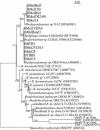Bacteria of the genus Rhodopseudomonas (Bradyrhizobiaceae): obligate symbionts in mycelial cultures of the black truffles Tuber melanosporum and Tuber brumale
- PMID: 27468385
- PMCID: PMC4947074
- DOI: 10.1186/s40064-016-2756-6
Bacteria of the genus Rhodopseudomonas (Bradyrhizobiaceae): obligate symbionts in mycelial cultures of the black truffles Tuber melanosporum and Tuber brumale
Abstract
Background: This work aimed at characterizing 12 isolates of the genus Tuber including Tuber melanosporum (11 isolates) and Tuber brumale (one isolate). This was done using internal transcribed spacer (ITS) sequences, confirming their origin.
Results: Analysis of their mating type revealed that both MAT1-1 and MAT1-2 exist within these isolates (with 3 and 8 of each, respectively). We observed that each of these cultures was consistently associated with one bacterium that was intimately linked to fungal growth. These bacterial associates failed to grow in the absence of fungus. We extracted DNA from bacterial colonies in the margin of mycelium and sequenced a nearly complete 16S rDNA gene and a partial ITS fragment. We found they all belonged to the genus Rhodopseudomonas, fitting within different phylogenetic clusters. No relationships were evidenced between bacterial and fungal strains or mating types. Rhodopseudomonas being a sister genus to Bradyrhizobium, we tested the nodulation ability of these bacteria on a promiscuously nodulating legume (Acacia mangium), without success. We failed to identify any nifH genes among these isolates, using two different sets of primers.
Conclusions: While the mechanisms of interaction between Tuber and Rhodopseudomonas remain to be elucidated, their interdependency for in vitro growth seems a novel feature of this fungus.
Keywords: Ascomycete; Cultivability; In vitro production; Procaryote; Truffle.
Figures



Similar articles
-
Mycorrhization of pecan (Carya illinoinensis) with black truffles: Tuber melanosporum and Tuber brumale.Mycorrhiza. 2017 Apr;27(3):303-309. doi: 10.1007/s00572-016-0743-y. Epub 2016 Nov 12. Mycorrhiza. 2017. PMID: 27838857
-
Isolation and characterization of MAT genes in the symbiotic ascomycete Tuber melanosporum.New Phytol. 2011 Feb;189(3):710-722. doi: 10.1111/j.1469-8137.2010.03492.x. Epub 2010 Oct 20. New Phytol. 2011. PMID: 20961294
-
Colonization by Tuber melanosporum and Tuber indicum affects the growth of Pinus armandii and phoD alkaline phosphatase encoding bacterial community in the rhizosphere.Microbiol Res. 2020 Oct;239:126520. doi: 10.1016/j.micres.2020.126520. Epub 2020 Jun 3. Microbiol Res. 2020. PMID: 32526628
-
Impact of the competition between mating types on the cultivation of Tuber melanosporum: Romeo and Juliet and the matter of space and time.Mycorrhiza. 2014 Apr;24 Suppl 1:S19-27. doi: 10.1007/s00572-013-0551-6. Epub 2014 Jan 3. Mycorrhiza. 2014. PMID: 24384788 Review.
-
Current state and perspectives of truffle genetics and sustainable biotechnology.Appl Microbiol Biotechnol. 2006 Sep;72(3):437-41. doi: 10.1007/s00253-006-0519-y. Epub 2006 Jun 27. Appl Microbiol Biotechnol. 2006. PMID: 16802150 Review.
Cited by
-
Chinese Black Truffle-Associated Bacterial Communities of Tuber indicum From Different Geographical Regions With Nitrogen Fixing Bioactivity.Front Microbiol. 2019 Nov 5;10:2515. doi: 10.3389/fmicb.2019.02515. eCollection 2019. Front Microbiol. 2019. PMID: 31749786 Free PMC article.
-
Black Truffles Affect Quercus aliena Physiology and Root-Associated nirK- and nirS-Type Denitrifying Bacterial Communities in the Initial Stage of Inoculation.Front Microbiol. 2022 Apr 28;13:792568. doi: 10.3389/fmicb.2022.792568. eCollection 2022. Front Microbiol. 2022. PMID: 35572648 Free PMC article.
-
Advances in molecular genetics have increased knowledge of Tuber species' life cycle and population genetic structure, indicating ways to improve yield.Mycorrhiza. 2024 Dec 13;35(1):2. doi: 10.1007/s00572-024-01177-1. Mycorrhiza. 2024. PMID: 39671091 Review.
-
Tuber melanosporum shapes nirS-type denitrifying and ammonia-oxidizing bacterial communities in Carya illinoinensis ectomycorrhizosphere soils.PeerJ. 2020 Sep 3;8:e9457. doi: 10.7717/peerj.9457. eCollection 2020. PeerJ. 2020. PMID: 32953252 Free PMC article.
-
Management of Plant Beneficial Fungal Endophytes to Improve the Performance of Agroecological Practices.J Fungi (Basel). 2022 Oct 15;8(10):1087. doi: 10.3390/jof8101087. J Fungi (Basel). 2022. PMID: 36294652 Free PMC article. Review.
References
-
- Antony-Babu S, Deveau A, Van Nostrand JD, Zhou J, Le Tacon F, Robin C, Frey-Klett P, Uroz S. Black truffle-associated bacterial communities during the development and maturation of Tuber melanosporum ascocarps and putative functional roles. Environ Microbiol. 2013;115:163–170. - PubMed
-
- Bâ A, Duponnois R, Diabaté M, Dreyfus B. Les champignons ectomycorhiziens des arbres forestiers en Afrique de l’Ouest. Marseille: Institut de recherche pour le développement (IRD); 2011.
-
- Barbieri E, Potenza L, Rossi I, Sisti D, Giomaro G, Rossetti S, Beimfohr C, Stocchi V. Phylogenetic characterization and in situ detection of a Cytophaga-Flexibacter-Bacteroides phylogroup bacterium in Tuber borchii Vittad. ectomycorrhizal mycelium. Appl Environ Microbiol. 2000;66:5035–5042. doi: 10.1128/AEM.66.11.5035-5042.2000. - DOI - PMC - PubMed
-
- Barbieri E, Riccioni G, Pisano A, Sisti D, Zeppa S, Agostini D, Stocchi V. Competitive PCR for quantitation of a Cytophaga-Flexibacter-Bacteroides phylum bacterium associated with the Tuber borchii Vittad. mycelium. Appl Environ Microbiol. 2002;68:6421–6424. doi: 10.1128/AEM.68.12.6421-6424.2002. - DOI - PMC - PubMed
LinkOut - more resources
Full Text Sources
Other Literature Sources

